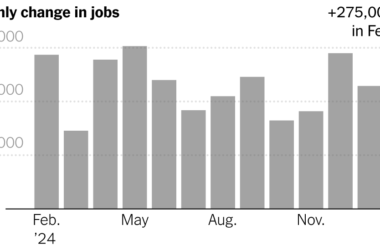Farmers who develop contemporary fruit and veggies are sometimes discovering crop insurance coverage prohibitively costly — and even unavailable — as local weather change escalates the probability of drought and floods able to decimating harvests.
Their predicament has left some small farmers questioning their future on the land.
Efforts to extend the provision and affordability of crop insurance coverage are being thought of in Congress as a part of the following farm invoice, however divisions between the pursuits of massive and small farmers loom over the talk.
The menace to farms from local weather change is just not hypothetical. A 2021 study from researchers at Stanford College discovered that rising temperatures had been accountable for 19 % of the $27 billion in crop insurance coverage payouts from 1991 to 2017 and concluded that further warming considerably will increase the probability of future crop losses.
About 85 % of the nation’s commodity crops — which embrace row crops like corn, soybeans and wheat — are insured, in keeping with the Nationwide Sustainable Agriculture Coalition, a nonprofit selling environmentally pleasant meals manufacturing.
In distinction, barely half the land dedicated to specialty crops — grocery store staples like strawberries, apples, asparagus and peaches — was insured in 2022, federal statistics present.
Amongst these going with out insurance coverage is Bernie Smiarowski, who farms potatoes on 700 acres in western Massachusetts, together with 12 acres for strawberries. His soil is taken into account a number of the nation’s most fertile. The trade-off is the proximity to the Connecticut River, a discount that grows extra tenuous as a warming world heightens the probability of flooding.
Mr. Smiarowski misplaced almost $1.25 million value of potatoes to floods final yr, when heavy rains pummeled the realm and water from the river seeped into his fields. It was the third straight yr of difficult climate.
“We had two extraordinarily moist years, sandwiched round one of many driest years I’ve ever seen,” he mentioned. “We will’t maintain one other yr like final yr.”
Even in an atypical yr, his bills of $2,000 an acre yield returns starting from a 20 % revenue to simply breaking even. Mr. Smiarowski mentioned the least costly plans quoted to him — round $170 an acre yearly — can be a big outlay however would cowl solely 60 % of the potatoes’ wholesale worth.
He sees the case for insurance coverage, however for now, he’s merely hoping for the most effective.
And specialty farmers say few brokers will work with them. “I do know of just one within the state,” mentioned Mike Koeppl, who grows strawberries on seven acres close to Oshkosh, Wis.
Their reluctance is monetary, consultants say. Brokers earn more money insuring huge tracts of corn and soybeans. The common American farm is 445 acres, in keeping with the U.S. Division of Agriculture, however the common specialty farm is significantly smaller.
And most insurance coverage cowl a single crop, which means specialty farmers rising quite a lot of fruit and veggies want to purchase a number of insurance policies.
Firms providing crop insurance coverage stress that their plans should supply payouts that roughly equal the insurance coverage premiums taken in.
Kristen Ward, regional vp for crop insurance coverage for Farm Credit score Mid-America, mentioned that her firm labored with farmers in six states, overlaying crops from barley to grapes, however that it couldn’t accomplish that in locations the place circumstances weren’t conducive to specialty fruit and veggies.
Premiums provided to farmers are based mostly on threat, “which is rated accordingly for the place the crop is grown,” she mentioned. “That will look completely different in numerous components of the nation.”
Merchandise to fill such gaps have emerged, together with entire farm income safety, a complete insurance coverage coverage for farms rising a number of crops.
Greater than 220,000 American farms develop specialty crops, in keeping with the American Farm Bureau Federation, a commerce group. However solely 18,659 entire farm income plans have been offered within the decade they’ve been provided, federal statistics present.
Advocates for the small specialty farmers need to Washington for aid.
The federal crop insurance coverage program was born through the Nice Melancholy, when the Mud Bowl ravaged the farm belt. Beneath the $18 billion program, the federal government pays half a farmer’s crop insurance coverage premium to ensure a safe meals provide.
In December, Congress prolonged the present farm invoice via 2024, however lawmakers have been unable to agree on what’s going to comply with.
The Nationwide Sustainable Agriculture Coalition just lately launched a set of suggestions together with easing entry to entire farm income insurance coverage and increasing catastrophe aid.
“Floods, drought and hurricanes are all turning into extra frequent and powerful,” mentioned Billy Hackett, a coverage specialist for the coalition. “That’s why it’s essential to have a security web.”
Senator Debbie Stabenow, a Michigan Democrat, has proposed language within the farm invoice giving specialty farmers entry to extremely backed insurance coverage insurance policies and streamlining the appliance course of for merchandise like entire farm income protection. “I’ll at all times combat to guarantee that specialty crops are a central a part of farm coverage,” Ms. Stabenow mentioned in a press release.
A stand-alone invoice, whose co-sponsors embrace Senator Cory Booker, Democrat of New Jersey, gives incentives for insurance coverage brokers to work with small and specialty crop farmers. The invoice bases subsidies on the complexity of an insurance coverage plan, somewhat than the scale of the premium.
However commodity farmers are cautious of modifications to the crop insurance coverage program.
Growers of corn, soybeans and wheat fear about “altering how this system capabilities broadly in a method that units everybody again somewhat than serving to to fill the gaps that exist for sure crops,” mentioned Danny Munch, an economist for the American Farm Bureau Federation.
Some lawmakers oppose adjustments due to these considerations.
“For years, Iowa farmers have informed me to go away crop insurance coverage alone within the subsequent farm invoice,” Senator Charles E. Grassley, Republican of Iowa — a state closely depending on commodity crops like corn and soybeans — mentioned in a press release. “There’s no must fiddle with one thing that’s not damaged.”
The deadlock has led some farmers to pursue different types of help.
After Mr. Smiarowski’s Massachusetts crop was ruined final yr, he and different farmers affected by the flood appealed to Gov. Maura Healey for assist, which got here within the type of catastrophe aid. Mr. Smiarowski was grateful, however he mentioned his share lined solely about 20 % of his losses.
The assist was additionally non permanent, leaving him with no possibility however to want for extra favorable climate sooner or later.
“When occasions are dangerous, you get what you’ll be able to and also you hope for a greater yr subsequent yr,” he mentioned.




